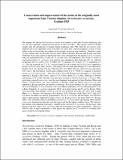| dc.description.abstract | The tilapiine fish species Oreochromis esculentus was endemic to only lakes Victoria and Kyoga, and
was the most important commercial fish species in these two lakes. This species started to decline
steadily after the introduction of modern fishing technology until 1960 when the last reserves were
depleted and is now apparently extinct from these two lakes. This situation prompted a search of water
bodies in the two basin lakes for evidence of its possible survival in some localities. Therefore a study
of four satellite lakes in the Lake Victoria basin (Mburo, Kachera, Kayanja and Kayugi) and three
(Nabisojjo, Kawi and Lemwa) in the Kyoga basin were investigated for the presence of O. esculentus
using an experimental fleet of gill nets to try and assess the populations that would be useful in
conservation efforts. O. esculentus were relatively most abundant in Lake Nabisojjo (58.1 %), followed
by Kayanja (22.6 %), Lemwa (14.2 %), Mburo (6.3 %), Kachera (5.9 %), Kawi (1.7 %) and Kayugi (1.4
%). The fish examined was 7.5- 38.7 cm total length (tl) with a modal size of 16-21 cm tl compared to
records of 30-32 cm in Lake Victoria. The largest fish was from Lake Kayugi 38.7 cm, followed by
Kachera (28.5 cm), Kayanja (28 cm), Nabisojjo (26.7 cm), Mburo (26 cm) , Kawi (25 cm) and Lemwa
(24.5 cm) tl. The fish had an overall mean condition factor k of 1.77±0.02 as compared to historical
records of 2 in Lake Victoria. Fish from Lakes Kawi and Kachera had the highest k (1.92± 0.02)
followed by Kayugi (1.90 ± 0.03), Lemwa (1.78 ± 0.03), Mburo (1.71 ± 0.01), Nabisojjo (1.65±0.02
and Kayanja (1.50 ± 0.02). Diatoms were previously recorded as the best food for O. esculentus. Blue
green algae especially microcysts, were the most dominant item ingested in Lakes Kachera, Mburo and
Lemwa. Planktolyngbya was most important in Kayanja, while the diatom aulacosira was most
important in Kayugi and Kawi and detritus in Nabisojjo. Size at first maturity was 20.5 cm tl in Kayugi,
19.4 cm in Nabisojjo, 17.2 cm in Lemwa, 16.8 cm in Mburo and Kachera, 15.6 cm in Kayanja and 12.5 cm
in Kawi. Originally, O. esculentus matured at 26-27 cm in Lake Victoria and 21 cm tl in Kyoga. There
were more males than females (1:0.83) as was the case in historical records. Sex ratios were in Lake
Mburo 1:1.1, Kachera 1:0.9, Kayanja 1:0.85, Kayugi 1:0.97, Nabisojjo 1:0.69, Kawi 1:0.52, and 1:0.75
in Lemwa. Fecundity was directly proportional to size of O. esculentus and the highest was (963±148
eggs) in Lake Kayugi, followed by Lemwa (532 ± 18), Kachera (518 ± 24), Kawi (507± 32), Kayanja
(468 ± 184), Nabisojjo (429±11) and Mburo (341±19). O. esculentus from Lake Kayugi where diatoms
(aulacosira) dominated in their diet were the largest and had the highest condition factor. This indicates
that diatoms were important food and is valuable in the survival of O. esculentus. On this basis, Lake
Kayugi is the best source of O. esculentus either for restocking or for captive propagation. However,
with the shift of algal communities to blue greens the capacity for O. esculentus to assimilate blue greens should be investigated further. | en_US |

